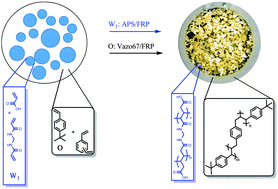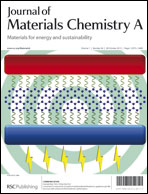Double emulsion template suspension polymerisation: towards the synthesis of polyelectrolyte core porous hydrophobic shell particles for environmental applications†
Abstract
Herein we report a novel synthetic strategy for the synthesis of micrometre sized core–shell particles comprising a polyelectrolyte core and a porous hydrophobic shell. A water-in-oil-in-water (W1/O/W2) double-emulsion was used as the template for the simultaneous polymerisation of both the internal aqueous and the intermediate oil phase leading to the formation of a cross-linked poly(acrylic acid) (PAAc) core contained in a poly(4-tert-butylstyrene-co-divinylbenzene) (poly(4-tBSty-co-DVB)) shell. The mass transport process from the internal aqueous phase to the external phase was reduced by means of an “oil phase locking” mechanism in which a rapid gel point transition of the oil phase ensured stability against internal aqueous–external aqueous phase (W1–W2) coalescence. The formation of core–shell particles was favoured by the effect of acrylic acid monomer which was responsible for the selective destabilization of the internal aqueous/oil interface (W1/O) allowing rapid internal aqueous phase coarsening. The particles thus obtained were investigated as potential sorbent materials for the simultaneous removal and encapsulation of organic and inorganic cationic species from aqueous solutions.


 Please wait while we load your content...
Please wait while we load your content...